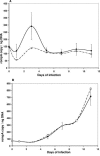Isolation and identification of Rickettsia massiliae from Rhipicephalus sanguineus ticks collected in Arizona
- PMID: 16885311
- PMCID: PMC1538723
- DOI: 10.1128/AEM.00122-06
Isolation and identification of Rickettsia massiliae from Rhipicephalus sanguineus ticks collected in Arizona
Abstract
Twenty Rhipicephalus sanguineus ticks collected in eastern Arizona were tested by PCR assay to establish their infection rate with spotted fever group rickettsiae. With a nested PCR assay which detects a fragment of the Rickettsia genus-specific 17-kDa antigen gene (htrA), five ticks (25%) were found to contain rickettsial DNA. One rickettsial isolate was obtained from these ticks by inoculating a suspension of a triturated tick into monolayers of Vero E6 monkey kidney cells and XTC-2 clawed toad cells, and its cell culture and genotypic characteristics were determined. Fragments of the 16S rRNA, GltA, rOmpA, rOmpB, and Sca4 genes had 100%, 100%, 99%, 99%, and 99%, respectively, nucleotide similarity to Rickettsia massiliae strain Bar29, previously isolated from R. sanguineus in Catalonia, Spain (L. Beati et al., J. Clin. Microbiol. 34:2688-2694, 1996). The new isolate, AZT80, does not elicit cytotoxic effects in Vero cells and causes a persistent infection in XTC-2 cells. The AZT80 strain is susceptible to doxycycline but resistant to rifampin and erythromycin. Whether R. massiliae AZT80 is pathogenic or infectious for dogs and humans or can cause seroconversion to spotted fever group antigens in the United States is unknown.
Figures






References
-
- Babalis, T., Y. Tselentis, V. Roux, A. Psaroulaki, and D. Raoult. 1994. Isolation and identification of a rickettsial strain related to Rickettsia massiliae in Greek ticks. Am. J. Trop. Med. Hyg. 50:365-372. - PubMed
-
- Babalis, T., H. T. Dupont, Y. Tselentis, C. Chatzichristodoulou, and D. Raoult. 1993. Rickettsia conorii in Greece: comparison of a microimmunofluorescence assay and Western blotting for seroepidemiology. Am. J. Trop. Med. Hyg. 48:784-792. - PubMed
-
- Beati, L., J.-P. Finidori, B. Gilot, and D. Raoult. 1992. Comparison of serologic typing, sodium dodecyl sulfate-polyacrylamide gel electrophoresis protein analysis, and genetic restriction fragment length polymorphism analysis for identification of rickettsiae: characterization of two new rickettsial strains. J. Clin. Microbiol. 30:1922-1930. - PMC - PubMed
MeSH terms
Substances
Associated data
- Actions
- Actions
- Actions
- Actions
- Actions
- Actions
LinkOut - more resources
Full Text Sources
Molecular Biology Databases

